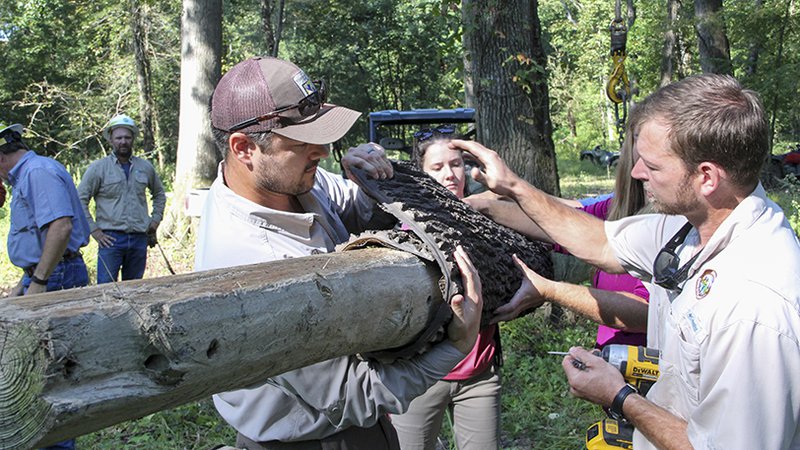Recycled utility poles offer endangered bats refuge
ON 09-18-2019

Sept. 18, 2019
Randy Zellers
Assistant Chief of Communications
WALNUT RIDGE — Last Thursday crews from Craighead Electric Cooperative, the Arkansas Game and Fish Commission, Arkansas State University, SWCA Environmental Consultants, and the U.S. Fish and Wildlife Service’s Arkansas Ecological Services Field Office placed special surrogate structures on Shirey Bay Rainey Brake Wildlife Management Area to encourage the continued use of the area by Indiana bats, an endangered species native to Arkansas.
Earlier this year, the only currently known maternity roost in Arkansas was identified on the WMA, but researchers feared the tree where the roost was located would be at risk for falling during storms. They also wanted to offer increased roosting opportunities for other Indiana bats to help in the recovery of the species. After coordinating with many partners, biologists developed a plan to help ensure long-term survival of the colony.
New roosting structures were created with used utility poles, donated by Craighead Electric Cooperative. Craighead Electric also donated labor and the use of a special track auger to dig and place the pole. The poles were made more usable for the bats by scoring the sides so bats could grip them more easily and covering them in BrandenBark. This artificial bark is used in zoos and theme parks. Three sheets of the material were donated to this project by The Nature Conservancy. The resulting structure should last much longer than the deteriorating tree where the bats have been roosting.
The maternity colony was located at Shirey Bay as a result of a separate project sponsored by the U.S. Fish and Wildlife Service, U.S. Forest Service, Arkansas Department of Transportation, Arkansas State University, and the Commission. Female Indiana bats were captured in April at a cave they used for hibernation in Newton County and one was followed as she migrated eastward across the Ozarks and finally settled down at Shirey Bay Rainey Brake WMA. Later, teams from ASU and Copperhead Consulting captured more bats and tracked them for several weeks while they foraged for insects on the WMA.
The Indiana bat was first listed as endangered in 1967 under the precursor to the current Endangered Species Act. Researchers have discovered that protection of summer roosting areas was as critical to the species survival as winter hibernation areas. The species hibernates in caves and mines, but tends to spend summer months roosting under the loosened bark of many old and deteriorating trees. As the trees continue to deteriorate, they eventually lose this bark, leaving the bats to find a new roost location. Experiments at Fort Knox Military Installation in Kentucky and other known summer roost sites have shown very promising results by using structures similar to those used in the Shirey Bay Rainey Brake Project.
Recent News
Subscribe to Our Weekly Newsletter E-mails
Don’t miss another issue. Sign up now to receive the AGFC Wildlife Weekly Newsletter in your mailbox every Wednesday afternoon (Waterfowl Reports are published weekly during waterfowl season and periodically outside the season). Fishing Reports arrive on Thursdays. Fill in the following fields and hit submit. Thanks, and welcome!


